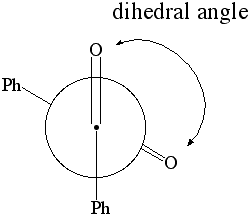
Week 4 Problem Set - 30BL (Turn in your computer assignment during week 5)
PART I. (Reduction of Camphor)
This assignment is to be completed in the UCLA Science Learning Center computing labs during the lab period (or afterwards if you don't complete it in the allotted time).
1. Optimize the above structural geometry of borneol, camphor and isoborneol. (see below instructions). Compare the heat of formation of borneol and isoborneol. Which one is more stable product (thermodynamic product)? How can you rationalize the differences?
2. Determine the dipol momentum for borneol, camphor and isoborneol. (see below instructions). In the GC spectrum, camphor has the shortest retention time, then isoborneol and borneol last. Can you rationalize the GC results based on the calculated dipole momenta of these compounds? (Note: The GC column is weakly polar.)
 |
Instructions:
- Build, minimize and save the structure. (don't forget to Minimize the structure after building it!!)
this is the minimize button. Always minimize your structure before leaving the building mode.
- click on
to enter View Mode
- Select Calculations from the Setup menu.
The following window should appear. Select the options shown.
Verify the Charge is Neutral and Multiplicity is Singlet. Click OK.
- Select Submit from Setup menu.
- When the calculation is completed you will be notified.
- Select Output from the Display menu.
Record the heat of formation value given
See these Helpful Hints for manipulating structures!
Note:
| 1 au = 1 hartree = 627.5 kcal/mol |
| 1 eV = 23.06 kcal/mol |
| 1 hartree = 27.21 eV |
| 1 Ångstrom = 1.889762 atomic units = 10-8 cm |
PART II. (Aldol Condensation)
|
1. Calculate the dipole moment for dihedral angles: 0 through 180 degrees in 15 degree increments. Plot the dipole moment of benzil vs. the dihedral angle. |

Newman Projection of Benzil |
Instructions:
- click on Constrain Dihedral angle tool,
- select the atoms shown below (i.e., both oxygens and and carbonyl carbons in the sequence O..C..C..O))
- Click on the lock tool,
, in the bottom right corner so that it looks like this,

- Set the dihedral angle to 0 and hit the ENTER key.
- click on the minimize tool,
, and wait for the operation to complete.
- click on the minimize tool,
, a second time and wait for the operation to complete.
- Select Calculations from the Setup menu. The following window should appear. Select the options shown.
- Make sure the

- Click OK to close the window.
- Select Submit from Setup menu. When the calculation is completed you will be notified.
- Under the Display menu, select Properties.
- A window should appear (the values in this example should differ from yours). If there are no values in the window then you need to double click on the molecule.
- Record the dipole moment and energy given. (In this example the dipole = 3.9 debye).
- Calculate the dipole moment for dihedral angles: 0 through 180 degrees in 15 degree increments. (Hint: Just click on the pink bond and change the value in the box.). Do not define a new constraint at this point. This will confuse the program completely!
- For the higher angles (>120 degrees), you might have to uncheck the symmetry box in the setup calculation menu. However, sometimes it works better if the approach is for the higher angles is from 180 degrees going down.
- Using EXCEL, plot the dipole moment and energy of benzil vs. the dihedral angle (use MS Excel, XY Scatter plot). Do you see any trends? If so, rationalize this observation.
Part III: Phase Transfer Oxidation (due in prelab)
1. Gas Chromatography
a. Why is it necessary to use fairly diluted solutions for the GC run?
b. A mixture of cyclohexane, bromocyclohexane and cyclohexene is dissolved in dichloromethane. A GC spectrum is acquired for this mixture isothermally at 80 oC. Determine the sequence of in which the compounds will elute from the GC column if polyethylene is used as stationary phase.
c. What would change if the spectrum would be obtained starting at 60oC and ending it at 100 oC (within 10 minutes)?
d. A student observes the following areas: cyclohexane: 60 units, bromocyclohexane: 40 units, cyclohexane: 20 units, dichloromethane: 1000 units. Determine the percentage composition of the sample in regard of the products.
2. A separatory funnel is used this week during the work-up. Answer the following questions.
a. Why do you have to vent the sepratory funnel frequently when a low boiling solvent is used?
b. Why do you have to remove the stopper on top when you drain the solution out of the separatory funnel?
c. Which layer is removed first from the separatory funnel?
3. Referring to the reaction carried out in the lab, answer the following questions.
a. Which parameters determine the rate of reaction for the reaction?
b. Which function does the TBHS have in the reaction?
c. Why is column chromatography used during the work-up process?
d. Why is it important that the stationary phase is always wet during the chromatography step?